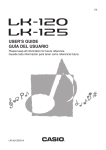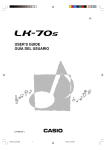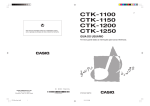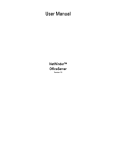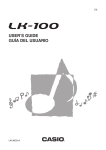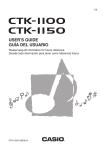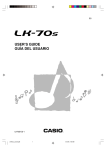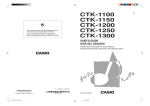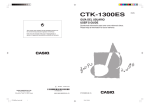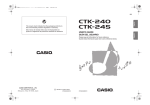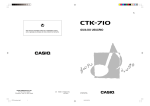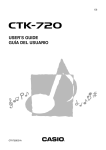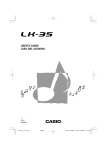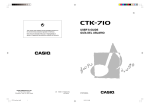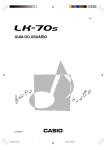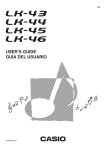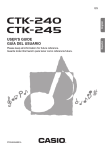Download Casio LK-130ES Owner's Manual
Transcript
LK-130ES GUÍA DEL USUARIO USER’S GUIDE Guarde toda información para tener como referencia futura. Please keep all information for future reference. This recycle mark indicates that the packaging conforms to the environmental protection legislation in Germany. Esta marca de reciclaje indica que el empaquetado conforma a la legislación de protección ambiental en Alemania. K CASIO COMPUTER CO.,LTD. 6-2, Hon-machi 1-chome Shibuya-ku, Tokyo 151-8543, Japan LK130ES_es_cover1-4.p65 1 MA1310-A Printed in China LK130ES-SE-1A 13.10.2, 11:32 AM ES/EN GUIDELINES LAID DOWN BY FCC RULES FOR USE OF THE UNIT IN THE U.S.A. (not applicable to other areas). NOTICE This equipment has been tested and found to comply with the limits for a Class B digital device, pursuant to Part 15 of the FCC Rules. These limits are designed to provide reasonable protection against harmful interference in a residential installation. This equipment generates, uses and can radiate radio frequency energy and, if not installed and used in accordance with the instructions, may cause harmful interference to radio communications. However, there is no guarantee that interference will not occur in a particular installation. If this equipment does cause harmful interference to radio or television reception, which can be determined by turning the equipment off and on, the user is encouraged to try to correct the interference by one or more of the following measures: • Reorient or relocate the receiving antenna. • Increase the separation between the equipment and receiver. • Connect the equipment into an outlet on a circuit different from that to which the receiver is connected. • Consult the dealer or an experienced radio/TV technician for help. FCC WARNING Changes or modifications not expressly approved by the party responsible for compliance could void the user’s authority to operate the equipment. Important! Please note the following important information before using this product. • Before using the optional AD-E95100L Adaptor to power the unit, be sure to check the AC Adaptor for any damage first. Carefully check the power cord for breakage, cuts, exposed wire and other serious damage. Never let children use an AC adaptor that is seriously damaged. • Never attempt to recharge batteries. • Do not use rechargeable batteries. • Never mix old batteries with new ones. • Use recommended batteries or equivalent types. • Always make sure that positive (+) and negative (–) poles are facing correctly as indicated near the battery compartment. • Replace batteries as soon as possible after any sign they are getting weak. • Do not short-circuit the battery terminals. • The product is not intended for children under 3 years. • Use only CASIO AD-E95100L adaptor. • The AC adaptor is not a toy. • Be sure to disconnect the AC adaptor before cleaning the product. This mark applies in EU countries only. Declaration of Conformity According to EU Directive Manufacturer: CASIO COMPUTER CO.,LTD. 6-2, Hon-machi 1-chome, Shibuya-ku, Tokyo 151-8543, Japan Responsible within the European Union: CASIO EUROPE GmbH Casio-Platz 1, 22848 Norderstedt, Germany LK130ES_e_00.p65 2 13.10.2, 11:34 AM Safety Precautions Before using the instrument, be sure to carefully read through the instructions contained in this manual. Symbols Various symbols are used in this user’s guide and on the product itself to ensure that the product is used safely and correctly, and to prevent injury to the user and other persons as well as damage to property. Those symbols along with their meanings are shown below. DANGER This symbol indicates information that, if ignored or applied incorrectly, creates the danger of death or serious personal injury. WARNING This indication stipulates matters that have the risk of causing death or serious injury if the product is operated incorrectly while ignoring this indication. Symbol Examples This triangle symbol ( ) means that the user should be careful. (The example at left indicates electrical shock caution.) This circle with a line through it ( ) means that the indicated action must not be performed. Indications within or nearby this symbol are specifically prohibited. (The example at left indicates that disassembly is prohibited.) The black dot ( ) means that the indicated action must be performed. Indications within this symbol are actions that are specifically instructed to be performed. (The example at left indicates that the power plug must be unplugged from the electrical socket.) CAUTION This indication stipulates matters that have the risk of causing injury as well as matters for which there is the likelihood of occurrence of physical damage only if the product is operated incorrectly while ignoring this indication. EN-1 LK130ES_e_01-07.p65 1 13.10.2, 11:34 AM DANGER Alkaline Batteries Perform the following steps immediately if fluid leaking from alkaline batteries ever gets into your eyes. 1. Do not rub your eyes! Rinse them with water. 2. Contact your physician immediately. Leaving alkaline battery fluid in your eyes can lead to loss of sight. WARNING Smoke, Strange Odor, Overheating Continued use of the product while it is emitting smoke, a strange odor, or heat creates the risk of fire and electric shock. Take the following steps immediately. 1. Turn off power. 2. If you are using the AC adaptor for power, unplug it from the wall outlet. 3. Contact your original retailer or an authorized CASIO Service Provider. AC Adaptor ● Misuse of the AC adaptor creates the risk of fire and electric shock. Always make sure you observe the following precautions. • Be sure to use only the AC adaptor that is specified for this product. • Use only a power source whose voltage is within the rating marked on the AC adaptor. • Do not overload electrical outlets and extension cords. ● Misuse of the AC adaptor’s electric cord can damage or break it, creating the risk of fire and electric shock. Always make sure you observe the following precautions. • Never place heavy objects on the cord or subject it to heat. • Never try to modify the cord or subject it to excessive bending. • Never twist or stretch the cord. • Should the electric cord or plug become damaged, contact your original retailer or authorized CASIO Service Provider. ● Never touch the AC adaptor while your hands are wet. Doing so creates the risk of electric shock. ● Use the AC adaptor where it will not be splashed with water. Water creates the risk of fire and electric shock. ● Do not place a vase or any other container filled with liquid on top of the AC adaptor. Water creates the risk of fire and electric shock. Batteries Misuse of batteries can cause them to leak, resulting in damage to nearby objects, or to explode, creating the risk of fire and personal injury. Always make sure you observe the following precautions. • Never try to take batteries apart or allow them to become shorted. • Never expose batteries to heat or dispose of them by incineration. • Never mix old batteries with new ones. • Never mix batteries of different types. • Do not charge the batteries. • Make sure the positive (+) and negative (–) ends of the batteries are facing correctly. EN-2 LK130ES_e_01-07.p65 2 13.10.2, 11:34 AM Do not incinerate the product. Never throw the product into fire. Doing so can cause it to explode, creating the risk of fire and personal injury. Water and Foreign Matter Water, other liquids, and foreign matter (such as pieces of metal, pencils, etc.) getting into the product create the risk of fire and electric shock. Take the following steps immediately. 1. Turn off power. 2. If you are using the AC adaptor for power, unplug it from the wall outlet. 3. Contact your original retailer or an authorized CASIO Service Provider. Disassembly and Modification Never try to take this product apart or modify it in any way. Doing so creates the risk of electric shock, burn injury, or other personal injury. Leave all internal inspection, adjustment, and maintenance up to your original retailer or authorized CASIO Service Provider. Plastic Bags Never place the plastic bag the product comes in over your head or in your mouth. Doing so creates the risk of suffocation. Particular care concerning this precaution is required where small children are present. Keep off of the product and stand.* Climbing onto the product or stand can cause it to tip over or become damaged. Particular care concerning this precaution is required where small children are present. Location Avoid locating the product on an unstable stand, on an uneven surface, or any other unstable location. An unstable location can cause the product to fall over, creating the risk of personal injury. Dropping and Impact Continued use of this product after it has been damaged by dropping or subjecting it to strong impact creates the risk of fire and electric shock. Take the following steps immediately. 1. Turn off power. 2. If you are using the AC adaptor for power, unplug it from the wall outlet. 3. Contact your original retailer or an authorized CASIO Service Provider. EN-3 LK130ES_e_01-07.p65 3 13.10.2, 11:34 AM CAUTION AC Adaptor ● Misuse of the AC adaptor creates the risk of fire and electric shock. Always make sure you observe the following precautions. • Do not locate the electric cord near a stove or other sources of heat. • Never pull on the cord when unplugging from the electrical outlet. Always grasp the AC adaptor when unplugging. • Insert the AC adaptor into the wall outlet as far as it will go. • Unplug the AC adaptor from the wall outlet during lightening storms or before leaving on a trip or other longterm absence. • At least once a year, unplug the AC adaptor from the wall outlet and wipe away any dust that is built up in the area around the prongs of the plug. • Never use detergent to clean the power cord, especially the plug and jack parts. Relocating the Product Before relocating the product, always unplug the AC adaptor from the wall outlet and disconnect all other cables and connecting cords. Leaving cords connected creates the risk of damage to the cords, fire, and electric shock. Cleaning Before cleaning the product, always unplug the AC adaptor from the wall outlet first. Leaving the AC adaptor plugged in creates the risk of damage to the AC adaptor, fire, and electric shock. Batteries Misuse of batteries can cause them to leak resulting in damage to nearby objects, or to explode, creating the risk of fire and personal injury. Always make sure you observe the following precautions. • Use only batteries that are specified for use with this product. • Remove batteries from the product if you do not plan to use it for a long time. Connectors Connect only the specified devices and equipment to the product’s connectors. Connection of a nonspecified device or equipment creates the risk of fire and electric shock. Location Avoid the following locations for this product. Such locations create the risk of fire and electric shock. • Areas subject to high humidity or large amounts of dust. • In food preparation areas or other areas subject to oil smoke. • Near air conditioning equipment, on a heated carpet, in areas exposed to direct sunlight, inside of a vehicle parked in the sun, or any other area that subjects the product to high temperatures. EN-4 LK130ES_e_01-07.p65 4 13.10.2, 11:34 AM Display Screen • Never push on the display screen’s LCD panel or subject it to strong impact. Doing so can cause the LCD panel’s glass to crack, creating the risk of personal injury. • Should the LCD panel ever crack or break, never touch the liquid inside of the panel. LCD panel liquid can cause skin irritation. • Should LCD panel liquid ever get inside your mouth, immediately wash out your mouth with water and contact your physician. • Should LCD panel liquid ever get into your eyes or onto your skin, rinse with clear water for at least 15 minutes, and then contact a physician. Sound Volume Do not listen to music at very loud volumes for long periods. Particular care concerning this precaution is required when using headphones. High volume settings can damage your hearing. Health Precaution In extremely rare cases, exposure to strong sudden light or flashing light can cause momentary muscle spasms, loss of consciousness, or other physical problems with some individuals. • If you suspect that you might be susceptible to any condition such as this, be sure to consult with your physician before using this product. • Use this product in an area that is well illuminated. Heavy Objects Never place heavy object on top of the product. Doing so can make the product top heavy, causing the product to tip over or the object to fall from it, creating the risk of personal injury. Correct Stand* Assembly An incorrectly assembled stand can tip over, causing the product to fall and creating the risk of personal injury. Make sure you assemble the stand correctly, following the assembly instructions that come with it. Make sure you mount the product on the stand correctly. * Stand is available as an option. IMPORTANT! When using batteries, be sure to replace them or shift to one of the alternate power sources whenever you notice any of the following symptoms. • • • • • • • • • • Instrument does not turn on Display that is flickering, dim, or difficult to read Abnormally low speaker/headphone volume Distortion of sound output Occasional interruption of sound when playing at high volume Sudden power failure when playing at high volume Flickering or dimming of the display when playing at high volume Continued sound output even after you release a key A tone that is totally different from the one that is selected Abnormal rhythm pattern and Song Bank play • Should you ever feel any symptoms similar to those described above when using this product, stop using it immediately and contact your physician. EN-5 LK130ES_e_01-07.p65 5 13.10.2, 11:34 AM Main Features ❐ On-screen fingering and timing indicators • Easy-to-understand on-screen indicators help to simplify keyboard play, even for novices. ❐ 100 amazingly realistic tones ❐ Enhanced auto-accompaniment function for greater versatility • 50 built in auto-accompaniment patterns. ❐ 100 Built-in Song Bank tunes • A total of 100 built-in Song Bank tunes comes built in for playback enjoyment or play-along practice. ❐ 3-Step Lesson System • Develop your musical skills by following the keys as they light. First you become familiar with the timing of the notes by watching the keys light as you playback one of the 100 built-in Song Bank tunes. Next, practice playing along at a pace that’s comfortable for you. Finally, try playing along at the normal tempo for the Song Bank tune. • A simulated human voice is used during Step 1 or Step 2 play to call out the fingers you should use to play the required notes (Voice Fingering). The timing of notes is also indicated on the display screen. ❐ Auto Accompaniment • Simply specify a chord and the keyboard automatically produces the matching rhythm, bass, and chord patterns. One-touch fill-ins make accompaniments sound interesting and natural. ❐ Transpose Function • An easy operation instantly changes the key of the keyboard. EN-6 LK130ES_e_01-07.p65 6 13.10.2, 11:34 AM Contents Safety Precautions ............. EN-1 3-Step Lesson System ..... EN-20 Using 3-Step Lesson System ............... EN-20 Main Features ..................... EN-6 General Guide ..................... EN-8 Attachment of Score Stand ..................... EN-9 Voice Fingering Guide .......................... EN-22 Timing Indicator .................................... EN-22 Step 1: Master the timing ...................... EN-23 Step 2: Master the melody .................... EN-24 Quick Reference ............... EN-10 Step 3: Play at normal speed ............... EN-24 To practice the left hand part ................ EN-25 Power Supply.................... EN-11 Using a Household Power Outlet ......... EN-11 Technical Reference......... EN-26 Using Batteries ..................................... EN-11 Troubleshooting .................................... EN-26 Auto Power Off ...................................... EN-12 Specifications ........................................ EN-28 Settings ................................................. EN-12 Connections...................... EN-13 Phones/Output Jack ............................. EN-13 Accessories and Options ...................... EN-13 Operating Precautions ..... EN-29 Appendix ............................... A-1 Tone List .....................................................A-1 Rhythm List ................................................A-2 Basic Operations .............. EN-14 Fingered Chord Charts .............................. A-3 To switch power on and off ................... EN-14 Song List ....................................................A-5 To change tones ................................... EN-14 Other Useful Functions ......................... EN-15 Playing the demo tunes ........................ EN-16 Playing rhythms .................................... EN-17 Using auto-accompaniment .................. EN-17 Improvising with the preset patterns ..... EN-19 EN-7 LK130ES_e_01-07.p65 7 13.10.2, 11:34 AM General Guide 1 2 3 4 5 6 7 8 C 9 0 A B 8 D E F I J G H K L M EN-8 LK130ES_e_08-12.p65 8 13.10.2, 11:34 AM N 1 ALIMENTACIÓN/MODO (POWER/MODE) selector E RITMO (RHYTHM) button 2 VOLUMEN (VOLUME) slider F TONO (TONE) button 3 SINCRO/RELLENO (SYNCHRO/FILL-IN) button G CANCIÓN (SONG BANK) button 4 INICIO/PARADA (START/STOP) button H Number buttons 5 DEMOSTRACIÓN (DEMO) button ● LECCIÓN EN 3 PASOS (3-STEP LESSON) 6 ILUMINACIÓN DE TECLAS (KEY LIGHT) button 7 TEMPO/VALOR (TEMPO/VALUE) buttons 8 Speakers I PASO 1 (STEP 1) button J PASO 2 (STEP 2) button K PASO 3 (STEP 3) button 9 100 MELODÍAS DEL BANCO DE CANCIONES (100 SONG BANK) list L SEL. PARTE (PART SELECT) button 0 Display M EJECUCIÓN NOTA POR NOTA (ONE KEY PLAY) buttons A 50 RITMOS (50 RHYTHMS) list N HABLAR (SPEAK) button B 100 TONOS (100 TONES) list C ACORDES (CHORD) root names D Percussion instrument list Rear Panel O P O PHONES/OUTPUT jack For connection of commercially available headphones. Output from the speakers is automatically cut when headphones are connected. P DC 9.5V jack * Attachment of Score Stand Insert both ends of the music stand provided with the keyboard into the two holes on the top surface. EN-9 LK130ES_e_08-12.p65 9 13.10.15, 10:52 AM Quick Reference This section provides a quick overview of keyboard operation using steps one and two of the 3-step lesson feature. See page EN-20 for detailed explanations of these steps. 1 1 2 Set the ALIMENTACIÓN/MODO (POWER/ MODE) selector to NORMAL. Press the CANCIÓN (SONG BANK) button. 5 2 3 4 5 5 Play the melody part on the keyboard. <If you pressed the PASO 1 (STEP 1) button in 4 ...> Play the notes with the EJECUCIÓN NOTA POR NOTA (ONE KEY PLAY) buttons. • The accompaniment tempo automatically adjusts to play along with your melody. SONG BANK indicator appears 3 Find the tune you want to play in the Song Bank list, and then use the number buttons to input its two-digit number. • To select “13 TWINKLE TWINKLE LITTLE STAR”, input 1 and then 3. Play the notes on the keyboard. • A sub-melody (obbligato) plays in time with the melody. • With Step 1, the correct melody note is played no matter which keyboard key you press. Tw i n k l e • Not all of the available songs are shown on the song bank list printed on the keyboard console. For a complete list, see the “Song List” on page A-5. 4 Press the PASO 1 (STEP 1) button or PASO 2 (STEP 2) button. <If you pressed the PASO 2 (STEP 2) button in 4 ...> Play the notes on the keyboard, pressing keys as they light. • When you do, the STEP 1 indicator or STEP 2 indicator appears. • The keyboard sounds a count beat and waits for you to play something on the keyboard. The keys that you need to press first flash. • Play in accordance with the fingerings that appear on the display. • Keep the key depressed as long as it stays lit. • If you selected any song from number 84 through 99, the lit key goes out as soon as you press it. • The key that corresponds to the next note you need to play will flash. • After you press the correct melody key, accompaniment proceeds to the next note. Tw i n k l e Fingering EN-10 LK130ES_e_08-12.p65 10 13.10.2, 11:34 AM Power Supply Prepare a household power outlet or batteries. IMPORTANT! • Be sure to comply with the “Safety Precautions” provided in this manual. Incorrect use of this product creates the risk of electric shock and fire. • Always make sure that the Digital Keyboard is turned off before plugging in or unplugging the AC adaptor, or before loading or removing batteries. Using a Household Power Outlet Using Batteries You can use six AA-size batteries for power. • Use alkaline or zinc-carbon batteries. Never use oxyride or any other nickel based batteries. Open the battery cover on the bottom of the Digital Keyboard, load the batteries, and then close the cover. • Take care to ensure that the positive (+) and negative (–) ends of the batteries are facing correctly. 1. Make sure that you use only the AC adaptor specified for this keyboard. Use of a different type of AC adaptor can cause malfunction. Specified AC Adaptor: AD-E95100L (JEITA Standard plug) 2. DC 9.5V terminal Household power outlet Remove the battery compartment cover. Load 6 AA-size batteries into the battery compartment. • Make sure that the positive (+) and negative (–) ends are facing correctly. AC adaptor 3. IMPORTANT! • The AC adaptor will become warm to the touch after very long use. This is normal and does not indicate malfunction. • To prevent breaking of the wire, take care to avoid putting any type of load on the power cord. No bending! Insert the tabs on the battery compartment cover into the holes provided and close the cover. Tab No winding! Important Battery Information • Never insert metal, pencils, or any other objects into the product's 9.5V DC terminal. Doing so creates the risk of accident. ■ The following shows the approximate battery life. Alkaline batteries .................................. 4 hours Zinc-carbon batteries ............................ 1 hour The above value is standard battery life at normal temperature, with the keyboard volume at medium setting. Temperature extremes or playing at very loud volume settings can shorten battery life. ■ Any of the following symptoms indicate low battery power. Replace batteries as soon as possible whenever any of the following occurs. • Instrument does not turn on • Display that is flickering, dim, or difficult to read • Abnormally low speaker/headphone volume • Distortion of sound output • Occasional interruption of sound when playing at high volume • Sudden power failure when playing at high volume • Flickering or dimming of the display when playing at high volume • Continued sound output even after you release a key • A tone that is totally different from the one that is selected • Abnormal rhythm pattern and Song Bank play EN-11 LK130ES_e_08-12.p65 11 13.10.2, 11:34 AM Auto Power Off The Digital Keyboard will turn off automatically to preserve power if you do not perform any operation for about six minutes. To disable Auto Power Off Hold down the TONO (TONE) button while turning on the keyboard to disable Auto Power Off. ❚ NOTE • When Auto Power Off is disabled, the keyboard does not turn off automatically no matter how long it is left with no operation being performed. • Auto Power Off is automatically enabled whenever you turn on keyboard power. Settings All keyboard settings are returned to their initial defaults whenever keyboard power is turned back on after being turned off by operation of the ALIMENTACIÓN/MODO (POWER/MODE) selector or Auto Power Off. EN-12 LK130ES_e_08-12.p65 12 13.10.2, 11:34 AM Connections Phones/Output Jack Accessories and Options Before connecting headphones or other external equipment, be sure to first turn down the volume settings of the keyboard and the connected equipment. You can then adjust volume to the desired level after connections are complete. Use only the accessories and options specified for this keyboard. Use of non-authorized items creates the danger of fire, electrical shock, and personal injury. [Rear Panel] PHONES/OUTPUT jack Audio connection • You can get information about accessories that are sold separately for this product from the CASIO catalog available from your retailer, and from the CASIO website at the following URL. http://world.casio.com/ 1 Stereo standard plug White 3 2 LEFT Red PIN plug RIGHT AUX IN or similar terminal of audio amplifier Keyboard amp, guitar amp, etc. Connecting Headphones (Figure 1) Connecting headphones cuts off output from the keyboard’s built-in speakers, so you can play even late at night without disturbing anyone. Audio Equipment (Figure 2) Connect the keyboard to an audio equipment using a commercially available connecting cord with a standard plug on one end and two PIN plugs on the other end. In this configuration, you normally set the input selector of the audio equipment to the terminal (usually marked AUX IN or something similar) where the cord from the keyboard is connected. See the user documentation that comes with your audio equipment for full details. Musical Instrument Amplifier (Figure 3) Use a commercially available connecting cord to connect the keyboard to a musical instrument amplifier. ❚ NOTE • Be sure to use a connecting cord that has standard plugs on the ends you connect to the keyboard and amplifier. [Connection Example] To keyboard’s PHONES/OUTPUT jack INPUT Standard plug Keyboard or guitar amp EN-13 LK130ES_e_13-19.p65 13 13.10.2, 11:34 AM Basic Operations ALIMENTACIÓN/MODO (POWER/MODE) VOLUMEN (VOLUME) DEMOSTRACIÓN (DEMO) RITMO (RHYTHM) TONO (TONE) Number buttons TEMPO/VALOR (TEMPO/VALUE) INICIO/PARADA (START/STOP) SINCRO/RELLENO (SYNCHRO/FILL-IN) This part of the manual provides you with the basic information you need to use your keyboard. To switch power on and off 1. 2. 3. 4. Set the ALIMENTACIÓN/MODO (POWER/ MODE) selector to NORMAL. Press the keyboard keys. Use the VOLUMEN (VOLUME) slider to set the volume to a relatively low level. To switch power off, set the ALIMENTACIÓN/ MODO (POWER/MODE) selector to OFF position. To change tones CANCIÓN (SONG BANK) ❚ NOTE • Always enter two digits for the tone number. If you enter only one digit, the display will automatically return to the previous tone number setting after a few seconds. • If you change the tone setting while a keyboard key is depressed, the tone does not change until you release the key and press a keyboard key again. • With certain tones (such as percussion sounds and sound effects), there may be very little or no change at all in the pitch, no matter which keyboard key you press. • If you input the wrong first digit for a tone number, you can return to the previous setting by pressing the TONO (TONE) button. Keyboard split tones Some of the preset tones split the keyboard and assign two or more sounds. With such a preset tone, the sound produced depends on what position of the keyboard you play. For example, BASS/PIANO (tone 90) puts BASS on the left and PIANO on the right of the keyboard. <Example> BASS/PIANO (No.90) 1. 2. Find the tone you want to use in the “Tone List” (page A-1) and note its tone number. Press the TONO (TONE) button. BASS PIANO Indicator appears Gr andPno 3. PERCUSSION (No.99) • PERCUSSION (Tone 99) assigns 35 percussion sounds to the keyboard as shown below. The sounds assigned to each key are indicated above the keyboard. Use the number buttons to input the 2-digit number that identifies the tone you want to select. Example: To select “26 ACOUSTIC BASS”, input 2 and then 6. Aco . Ba s s EN-14 LK130ES_e_13-19.p65 14 13.10.2, 11:34 AM BASS DRUM RIDE BELL SIDE STICK TAMBOURINE ACOUSTIC SNARE SPLASH CYMBAL To change the key of the keyboard HAND CLAP COWBELL ELECTRIC SNARE CRASH CYMBAL 2 LOW TOM 2 CLAVES CLOSED HI-HAT RIDE CYMBAL 2 The transpose feature of this keyboard lets you raise or lower its key in semitone increments. This means you can easily match to suit someone’s voice, and you can eliminate sharps and flats from music making it easier to play. LOW TOM 1 HIGH BONGO PEDAL HI-HAT LOW BONGO MID TOM 2 MUTE HIGH CONGA Other Useful Functions 1. OPEN HIGH CONGA OPEN HI-HAT LOW CONGA MID TOM 1 • Perform step 2 within five seconds after performing step 1. HIGH TIMBALE HIGH TOM 2 While in any mode besides the Song Bank Mode (indicated when the SONG BANK indicator is lit), hold down the TONO (TONE) button and press the RITMO (RHYTHM) button. LOW TIMBALE CRASH CYMBAL 1 T r ans HIGH AGOGO HIGH TOM 1 LOW AGOGO RIDE CYMBAL 1 CABASA CHINESE CYMBAL MARACAS 2. Use the TEMPO/VALOR (TEMPO/VALUE) buttons to change the key of the keyboard. Example: To change the tuning to B (indicated by -1 since it is one tone below C, which is the normal tuning of the keyboard). Polyphony The term polyphony refers to the maximum number of notes you can play at the same time. This keyboard has 12-note polyphony, which includes the notes you play as well as the rhythms and auto-accompaniment patterns that are played by the keyboard. This means that when a rhythm or autoaccompaniment pattern is being played by the keyboard, the number of notes (polyphony) available for keyboard play is reduced. Also note that some of the tones offer only 6-note polyphony. T r ans ( – ) B C D E F G A B C • When rhythm or auto accompaniment is playing, the number of sounds simultaneously played is reduced. • Though you can sound up to 12 notes at one time, only the last four keyboard keys pressed light up. F G A C D C E B Normal tuning <Keys and their indicators> F# Key : A G A B B C C# D E E F Display : Trans (–) Trans (+) : Pressing : Pressing <Note Names> C D E F G A B C EN-15 LK130ES_e_13-19.p65 15 13.10.2, 11:34 AM ❚ NOTE ❚ NOTE • If you leave the transpose screen on the display for about five seconds without doing anything, the screen is automatically cleared. • You cannot change the transpose setting while the keyboard is in the Song Bank Mode. • In step 2 of the above operation, you could also use the number buttons 0 to 5 to specify C through F. • Pressing both of the TEMPO/VALOR (TEMPO/VALUE) buttons ( / ) at the same time returns the transpose setting to C(0). • The transpose setting is automatically set to C(0) whenever you turn keyboard power on. • The transpose setting is automatically set to C(0) whenever you press the CANCIÓN (SONG BANK) button. • The pitch of a transposed note depends on the tone you are using. If the transpose operation causes a note to exceed the range of the tone you are using, the same note in the highest octave of the tone’s range is substituted. • The transpose operation does not affect tone number 99 (PERCUSSION) or auto-accompaniment rhythms. • Transposing tones 75 through 79 and 90 through 96 changes the range of keys to which each of the tones is assigned. • The transpose setting is automatically set to C(0) whenever you press the DEMOSTRACIÓN (DEMO) button. • If you leave the tuning screen on the display for about five seconds without doing anything, the screen is automatically cleared. • In step 2 of the above procedure, you could also use the number buttons to input a value from 00 to 50. • Pressing both of the TEMPO/VALOR (TEMPO/VALUE) buttons ( / ) at the same time returns the tuning setting to 00. • Pressing the CANCIÓN (SONG BANK) button changes the tuning setting to 00. • The tuning setting does not affect any of Song Bank tunes. • You can tune the keyboard within a range of approximately ±50 cents (100 cents = 1 semitone). • The tuning setting is automatically set to 00 whenever you turn the keyboard on. • Pressing the DEMOSTRACIÓN (DEMO) button changes the tuning setting to 00. • The tuning operation does not affect rhythm (99 PERCUSSION). To tune the keyboard A simple operation lets you tune the keyboard to another musical instrument. 1. While in any mode besides the Song Bank Mode (indicated when the SONG BANK indicator is lit), hold down the TONO (TONE) button and press the CANCIÓN (SONG BANK) button. Playing the demo tunes You can set up the keyboard to continually play its 100 builtin Song Bank tunes. Keyboard keys light to indicate the melody notes of the demo tune as it plays. To start demo tune play 1. Switch power on and adjust the volume level. 2. Press the DEMOSTRACIÓN (DEMO) button. • Demo tune play continues in a sequential endless loop until you switch it off. • The number and name of the demo tune currently playing are shown on the display. • You can play along on the keyboard while a demo tune is playing back. • Perform step 2 within five seconds after performing step 1. Tune 2. 3. Use the TEMPO/VALOR (TEMPO/VALUE) buttons to change the tuning of the keyboard. Example: To lower tuning by 20 Tune ( –) You can change the demo tune play being played by pressing the number buttons. • The Song Bank tunes play back in tune number sequence, starting from the one you select. To stop demo tune play Press the DEMOSTRACIÓN (DEMO) button or INICIO/ PARADA (START/STOP) button again to stop demo tune play. EN-16 LK130ES_e_13-19.p65 16 13.10.2, 11:34 AM 6. ❚ NOTE • Only the following buttons are enabled while a Song Bank tune is being played. • VOLUMEN (VOLUME) slider • Number buttons • INICIO/PARADA (START/STOP) button • ALIMENTACIÓN/MODO (POWER/MODE) selector (OFF) • DEMOSTRACIÓN (DEMO) button • ILUMINACIÓN DE TECLAS (KEY LIGHT) button • HABLAR (SPEAK) button • You cannot change the tone being used for the melody of a Song Bank tune. • Each time you press one of the TEMPO/VALOR (TEMPO/VALUE) buttons while the tempo value is displayed, the tempo setting changes one step, within the range of 040 to 255. • The initial default tempo setting when you turn on power is 120. • After displaying the current tempo setting by pressing the TEMPO/VALOR (TEMPO/VALUE) button in step 6, you can also input the tempo setting you want by inputting a three-digit value with the number buttons. • Holding down either of the TEMPO/VALOR (TEMPO/VALUE) buttons changes the tempo setting at high speed. • To reset the tempo to the standard value of each rhythm, press both TEMPO/VALOR (TEMPO/ VALUE) buttons. Playing rhythms This keyboard features a collection of 50 exciting built-in rhythm patterns. Each pattern provides percussion back up for all your performances. To select and play a rhythm 1. 2. 3. Set the ALIMENTACIÓN/MODO (POWER/ MODE) selector to NORMAL. Find the rhythm you want to use in the “Rhythm List” (page A-2) and note its rhythm number. Press the RITMO (RHYTHM) button. • When you do, the RHYTHM indicator appears. • The number and name that appear on the display indicate the currently selected rhythm. 4. Use the number buttons to input the 2-digit rhythm number for the rhythm you want to use. Use the TEMPO/VALOR (TEMPO/VALUE) buttons to adjust the tempo of the rhythm. 7. To stop rhythm play, press the INICIO/PARADA (START/STOP) button again. Using auto-accompaniment This keyboard features 50 accompaniment patterns that let you add full accompaniments to your performances automatically. With auto-accompaniment, part of the keyboard is reserved as an accompaniment keyboard. As you play your chords on the accompaniment keyboard, the accompaniment pattern adjusts automatically to follow the progression you play. You get a choice between two different methods for chord play. DIGITACIÓN (FINGERED) lets you play chords as you normally do, while ACORDES CASIO (CASIO CHORD) makes it possible to play fully formed chords with one finger. Example: To select “37 SAMBA”, input 3 and then 7. S amb a • Be sure to always specify a 2-digit number. • If you discover a mistake before you input the second digit, press the RITMO (RHYTHM) button to return to the previously set rhythm number. • You can change to another rhythm even while the current rhythm is sounding. 5. About the accompaniment keyboard The lower (left) 1.5 octaves are reserved for use as an accompaniment keyboard whenever you select ACORDES CASIO (CASIO CHORD) or DIGITACIÓN (FINGERED) with the ALIMENTACIÓN/MODO (POWER/MODE) selector. The panel above the accompaniment keyboard keys is marked with the names of the notes they play. The remainder of the keyboard (the part that is not included in the accompaniment keyboard) is called the melody keyboard. Please be sure to remember these terms, because they will be used throughout the rest of this manual. Press the INICIO/PARADA (START/STOP) button to start play of the rhythm. • When you do, the selected rhythm starts to sound. Accompaniment keyboard ( Melody keyboard The entire keyboard can be used for melody play while the ALIMENTACIÓN/MODO (POWER/MODE) selector is set to NORMAL. ) EN-17 LK130ES_e_13-19.p65 17 13.10.2, 11:34 AM Using the ACORDES CASIO (CASIO CHORD) system The ACORDES CASIO (CASIO CHORD) system lets you easily play the four main types of chords. Play of chords is simplified as shown in the chart below. Keys 5. 6. Continue pressing different keys on the accompaniment keyboard to play your chord progression. To stop auto-accompaniment play, press the INICIO/PARADA (START/STOP) button again. Example Type Pressing one Major accompaniment chord key C (C Major Chord) Pressing two Minor accompaniment chord keys Cm (C Minor Chord) Pressing Seventh three chord accompaniment keys C7 (C Seventh Chord) Pressing four Minor accompaniment seventh keys chord Cm7 (C Minor Seventh Chord) CC DE E FF GA A B B CC DE E F CC DE E FF GA A B B CC DE E F CC DE E FF GA A B B CC DE E F CC DE E FF GA A B B CC DE E F Using standard fingerings The DIGITACIÓN (FINGERED) mode lets you play a wider variety of chords. In this mode, you can start play of an accompaniment pattern by pressing three or four of the accompaniment keyboard keys. This keyboard is capable of recognizing 15 different chords. The following shows the fingerings of these chords with a root of C. Note that you can omit the fifth notes (which are shown inside parentheses in the illustrations below) to produce 7, m7, M7, add9, madd9, and mM7 chords. C Cm Cdim Caug (*1) Csus4 C7 Cm7 CM7 Cm75 C7 5 (*1) C7sus4 Cadd9 Cmadd9 CmM7 Cdim7 (*1) ❚ NOTE • The bottom (leftmost) note that you play determines the name of the chord. If the bottom note is a C for example, the keyboard produces a C chord. • When pressing more than one accompaniment key, it makes no difference whether the keys to the right of the bottom note are white or black. To play an ACORDES CASIO (CASIO CHORD) auto-accompaniment 1. 2. 3. Use the ALIMENTACIÓN/MODO (POWER/ MODE) selector to select ACORDES CASIO (CASIO CHORD). Select an auto-rhythm as described under “To select and play a rhythm” on page EN-17. Start play of the rhythm. • If you want to start play of the normal rhythm pattern, press INICIO/PARADA (START/STOP). • You can also use synchro start (page EN-19) to start rhythm play. 4. *1 With this chords, the lowest note in your fingering is always used as the root. Make sure that your fingering correctly identifies the root you want to use. Press either one or up to four keys on the accompaniment keyboard, and the corresponding accompaniment starts to play automatically. Chord name EN-18 LK130ES_e_13-19.p65 18 13.10.2, 11:34 AM IMPORTANT! • If you play one or two notes only in the left hand, or three notes that do not make up a recognizable chord formation, no sound will be produced. The DIGITACIÓN (FINGERED) mode requires a conventional three or fournote chord formation to produce an auto-accompaniment. Also, note that auto-chords only work in conjunction with rhythm patterns, and not independently of them. ❚ NOTE • The above examples show only one of the possible fingerings for each chord. Note that you can play the notes that form a chord in any combination. Each of the following fingerings for example, produces the same C chord. Improvising with the preset patterns Pressing the INICIO/PARADA (START/STOP) button to start rhythm play causes the normal version of the pattern to be played. You can also play a variation of the rhythm using the operation described below. Using fill-in rhythm You can insert a fill-in rhythm by pressing the SINCRO/ RELLENO (SYNCHRO/FILL-IN) button while an autorhythm plays. Using Synchro start You can start the rhythm and accompaniment pattern at the same time, with your play of the accompaniment keyboard. To do this, follow the steps below. Accompaniment keyboard 1. • See the “Fingered Chord Charts” on page A-3 for information on the fingerings of chords for all roots. To play a DIGITACIÓN (FINGERED) autoaccompaniment 1. 2. 3. 3. Use the ALIMENTACIÓN/MODO (POWER/ MODE) selector to select DIGITACIÓN (FINGERED). 4. Select an auto-rhythm as described under “To select and play a rhythm” on page EN-17. Select an auto-rhythm. Press the SINCRO/RELLENO (SYNCHRO/FILLIN) button. Press the accompaniment keys to play the first chord. As soon as you do, the autoaccompaniment pattern begins to play. Start play of the rhythm. • If you want to start play of the normal rhythm pattern, press INICIO/PARADA (START/STOP). • You can also use synchro start (on this page) to start rhythm play. 4. 2. Set the ALIMENTACIÓN/MODO (POWER/ MODE) selector to the ACORDES CASIO (CASIO CHORD) or DIGITACIÓN (FINGERED) position. 5. To stop the auto-accompaniment pattern play, press the INICIO/PARADA (START/STOP) button. ❚ NOTE Play a chord on the accompaniment keyboard to start play of the auto-accompaniment. • If you set the ALIMENTACIÓN/MODO (POWER/MODE) selector to NORMAL in step 1 on page EN-17, the operation in step 4 starts play of the rhythm (percussion instruments) only. Chord name 5. 6. Continue pressing keys on the accompaniment keyboard to play your chord progression. To stop auto-accompaniment play, press the INICIO/PARADA (START/STOP) button again. EN-19 LK130ES_e_13-19.p65 19 13.10.2, 11:34 AM 3-Step Lesson System ILUMINACIÓN DE TECLAS (KEY LIGHT) TONO (TONE) HABLAR (SPEAK) CANCIÓN (SONG BANK) EJECUCIÓN NOTA POR NOTA (ONE KEY PLAY) SEL. PARTE (PART SELECT) PASO 3 (STEP 3) PASO 1 (STEP 1) INICIO/PARADA (START/STOP) Using 3-Step Lesson System Even individuals who cannot play the keyboard at all can follow along with the 100 built-in Song Bank tunes with the EJECUCIÓN NOTA POR NOTA (ONE KEY PLAY) buttons. You can also use the 3-Step Lesson System to learn at your own pace. Play slowly at first until you are able to play along at normal speed. Of the 100 built-in tunes, numbers 00 through 83 feature autoaccompaniment (auto-accompaniment tunes), while 84 through 99 are played using both hands (two-hand tunes). The 3-Step Lesson System can be used with the following 3step lesson plan to master keyboard play. PASO 2 (STEP 2) ❚ NOTE • You may not be able to see the keyboard keys light under direct sunlight or in other brightly lit areas. 3-Step Lesson System Tempo Setting You can use the procedure in step 6 of the procedure on page EN-18 to set the tempo of the left-hand part for Song Bank and 3-Step Lesson System play (Step 1 through 3). This means you can use a slower tempo at the beginning, and then increase it as you learn. Press both of the TEMPO/ VALOR (TEMPO/VALUE) buttons ( and ) at the same time to return the tempo to its initial preset setting. To play a built-in Song Bank tune Step 1: Master the timing Pressing the EJECUCIÓN NOTA POR NOTA (ONE KEY PLAY) buttons plays the melody for an autoaccompaniment tune or the right hand part for twohand tunes. In both cases, the auto-accompaniment (the left hand part in the case of two-hand tunes) is played automatically by the keyboard. In place of the EJECUCIÓN NOTA POR NOTA (ONE KEY PLAY) buttons, you can also press any key of the keyboard to play the melody or right hand part. The purpose of this step is to familiarize yourself with the timing required to play melody notes. Step 2: Master the melody 1. • Not all of the available songs are shown on the song bank list printed on the keyboard console. For a complete list, see the “Song List” on page A-5. 2. Press the CANCIÓN (SONG BANK) button until the SONG BANK indicator appears. • This causes the number and name of the currently selected Song Bank tune to appear on the display. 3. In this step, you use the display to learn which fingers you should use to play, and the key light system to learn which keyboard keys to press. You can play at the pace you want, because the auto-accompaniment or left hand part waits until you press the correct key. Input the two digit number for the tune you want to play. Example: To select “13 TWINKLE TWINKLE LITTLE STAR”, input 1 and then 3. Tw i n k l e Step 3: Play at normal speed At this level, the keyboard’s keys still light to indicate which notes to play, but they no longer wait for you to press the correct key. The auto-accompaniment or left hand part is played at normal speed. Look up the number of the tune you want to play in the Song Bank list. 4. Press the INICIO/PARADA (START/STOP) button to start play of the selected tune. • The tune you select plays repeatedly, with the keyboard keys lighting to indicate the melody notes. EN-20 LK130ES_e_20-25.p65 20 13.10.2, 11:34 AM 5. 6. To stop Song Bank tune play, press the INICIO/ PARADA (START/STOP) button again. To exit the Song Bank Mode, press the CANCIÓN (SONG BANK) button again. Crossed Finger Indications The display also shows when you have to cross fingers to play notes, and in which direction your fingers should cross. Example: Display for playing the notes below with the right hand • When you do, the SONG BANK indicator goes out. ❚ NOTE • Always enter two digits for the Song Bank number. • You can input a Song Bank tune number even while another Song Bank tune is playing. • If you input the wrong first digit for a Song Bank tune number, you can return to the previous setting by pressing the CANCIÓN (SONG BANK) button. • The RITMO (RHYTHM) button is disabled in the Song Bank Mode. If you want to play a rhythm, press the CANCIÓN (SONG BANK) button to return to the normal mode first. Key Lighting System Operation and Display Contents During Song Bank Play Keyboard keys light to show the keys that should be pressed to play along with Song Bank tunes as they play back. At the same time, the display shows fingerings, chord names, tempo and other information. 3 A 1 B Using the Song Bank A 2 C 1 D 3 E Crossed finger display B C D E • B and C indicate that the index finger should cross over the thumb. • C and D indicate that the thumb should cross under the index finger. Key Lighting During Song Bank Play When you play back a Song Bank tune, keyboard keys light to show you the notes that are being played. Auto-accompaniment Song Bank Tune Tw i n k l e Chord and melody part keys light. Chord The root (the C-note of a C-chord) and other notes that make up the chord alternately light. Chord name Tempo value Melody note lights. Fingering ❚ NOTE • Some Song Bank tunes use chords (such as C6) that cannot be played with the DIGITACIÓN (FINGERED) setting (page EN-18). In the DIGITACIÓN (FINGERED) mode, chords may sound different from the ones produced by Song Bank tune playback, even if you finger the chords as indicated by the lit keys. Two-hand Song Bank Tune Left hand and right hand part keys light. Left hand part Right hand part EN-21 LK130ES_e_20-25.p65 21 13.10.2, 11:34 AM Key Lighting System Operation and Display Contents During 3-step Lesson Play Whenever you select an Auto Accompaniment tune (00 to 83) for 3-step lesson play, the key lighting system shows you which keys to press, while the display shows you the fingerings. Note Pitch The keyboard key that should be pressed lights. The fingers you should use to play the notes are also shown on the display. Voice Fingering Guide Voice fingering guide uses a simulated human voice to call out fingering numbers during Step 1 and Step 2 one-hand part practice. If you need to press a key with your thumb, for example, voice fingering guide says, “One!” In the case of a chord to be played with your thumb, middle and little finger, voice fingering guide says, “One, three, five!” Voice Fingering Guide calls out fingerings only when you do not press the proper key when you should. To turn voice fingering guide on and off Note Length Keyboard keys stay lit for as long as the note should be played. The fingerings also remain on the display for the length of the note. Use the HABLAR (SPEAK) button to turn voice fingering guide on and off. Next Note The keyboard key for the next note to be played flashes, while a number appears on the display near the finger you should use to play the next note. Voice fingering guide indicator Series of Same Pitch Notes Timing Indicator The keyboard key light turns off momentarily between the notes and lights again for each successive note. The fingerings also turn off and back on again. The timing indicator helps you become familiar with tunes you are playing for the first time by indicating the timing of notes you play on the keyboard. Timing is easier to see when you use a slow tempo during lesson play. Example: When play requires pressing keys with fingers 3, 2, and then 1 1st Note 2nd Note 3rd Note Using the Timing Indicator The timing indicator shows the timing of notes contained in the currently selected part (R or L). Notes are indicated as two-segment blocks that scroll from the top of the display, down to the bottom. A note is played when its block reaches the bottom of the display. Next note Current note Flash Lit Flash Lit Lit Flash Key light Upcoming note timing ❚ NOTE • Note length is not indicated when you are using two-hand tunes (84 to 99) with 3-Step Lesson Steps 1 and 2. As soon as you press a lit key, it goes out and the next key to be played starts to flash. • Note length is indicated by the key light system when you use a two-hand tune with Step 3. In this case, the next key to be pressed does not flash when you press a lit key and the next finger number does not appear on the display. Only the current finger number is shown. Note played here • Each two-segment block can indicate one or more notes, depending on the tune you are playing. ❚ NOTE • The Timing Indicator shows note timing whenever you play back a Song Bank tune and during a 3-Step Lesson. • Note that the Timing Indicator shows approximate timing only. EN-22 LK130ES_e_20-25.p65 22 13.10.2, 11:34 AM Turning Off Key Lighting Step 1: Master the timing 1. 1. Press the ILUMINACIÓN DE TECLAS (KEY LIGHT) button. Press the PASO 1 (STEP 1) button. • When you do, the STEP 1 indicator appears. • After a count sounds, the keyboard stands by and waits for you to play the first note of the tune. If the tune includes intro measures, the keyboard enters standby after the intro measures are complete. • The KEY LIGHT indicator disappears when the key light system is turned off. • Press the ILUMINACIÓN DE TECLAS (KEY LIGHT) button again to turn key lighting back on. Tw i n k l e KEY LIGHT indicator ❚ NOTE Key lighting turns on automatically in any of the following cases: • When keyboard power is turned on. • When the CANCIÓN (SONG BANK) button is pressed in the normal mode (page EN-20). Fingering Number of Simultaneously Lit Keys Up to four keyboard keys can be lit at the same time. 2. • The accompaniment (left hand) part of the tune follows along as you play the melody (right hand) part. • The keyboard key that corresponds to the next note to be played flashes, and lights when you play the note. • The rhythm (percussion) part does not sound. To change the tone used for the melody of a Song Bank tune 1. Following step 3 of the procedure on page EN-20, press the TONO (TONE) button. • Both the SONG BANK indicator and TONE indicator appear, along with the tone number and name of the tone that is currently assigned to the keyboard. 2. 3. Input a value to select the tone you want to use. Try pressing any one of the keyboard keys in place of the EJECUCIÓN NOTA POR NOTA (ONE KEY PLAY) buttons. • Pressing any keyboard key plays the correct melody (right hand part) note. • Pressing more than one key at the same time counts as a single melody note. Pressing a key while another key is held down is counted as two melody notes. ❚ NOTE • Selecting another Song Bank tune switches the tone setting to the newly selected tune’s preset melody tone. • The tone assigned to the keyboard is the same one specified for the melody of the Song Bank tune. • The above procedure can be used to change the Song Bank melody tone before starting play or while play is already in progress. • You can also change the tone of two-hand tunes (tune numbers 84 to 99). Note however, that selecting a sustainable tone (like an organ tone) when using 3-Step Lesson Step 1 or Step 2 (in which accompaniment waits for correct input from you before proceeding), can cause notes of the auto accompaniment to be sustained while the keyboard is waiting for your input. If this happens, play something on the keyboard to stop the sustained note. Press the EJECUCIÓN NOTA POR NOTA (ONE KEY PLAY) buttons to play each note of the tune. The correct note is played even if you do not press the key that is lit. 4. To stop play at any time, press the INICIO/ PARADA (START/STOP) button. • When you do, the STEP 1 indicator goes out. EN-23 LK130ES_e_20-25.p65 23 13.10.2, 11:34 AM Step 2: Master the melody Step 3: Play at normal speed 1. 1. Press the PASO 2 (STEP 2) button. • When you do, the STEP 2 indicator appears. • After a count sounds, the keyboard stands by and waits for you to play the first note of the tune. If the tune includes intro measures, the keyboard enters standby after the intro measures are complete. Press the PASO 3 (STEP 3) button. • When you do, the STEP 3 indicator appears. • Play starts after a count sounds. Tw i n k l e Tw i n k l e Fingering Fingering 2. 2. • The accompaniment (left hand) part of the tune plays at normal speed, regardless of what you play on the keyboard. • With an auto-accompaniment tune, the keyboard key that corresponds to the next note to be played flashes, and lights when the note should be played. • With a two-hand tune, the applicable keyboard key remains lit as long as its note plays. In this case, however, the key for the next note to be played does not flash. Keys light when their notes start to play. Play the notes indicated by the 3-Step Lesson System. • The accompaniment (left hand) part of the tune follows along as you play the melody (right hand) part. • The keyboard key that corresponds to the next note to be played flashes, and lights when you play the note. • The rhythm (percussion) part does not sound. Press keyboard keys as they light. More than one key may light when you are playing a two-hand tune. Press all keys that light. 3. To stop play at any time, press the INICIO/ PARADA (START/STOP) button. Play along on the keyboard, following the keys as they light. 3. To stop play at any time, press the INICIO/ PARADA (START/STOP) button. • When you do, the STEP 3 indicator goes out. • When you do, the STEP 2 indicator goes out. EN-24 LK130ES_e_20-25.p65 24 13.10.2, 11:34 AM To practice the left hand part Once you master right hand part play, you can use the twohand tunes (numbers 84 through 99) to practice left hand part. 1. Press the CANCIÓN (SONG BANK) button until the SONG BANK indicator appears. • This causes the number and name of the currently selected Song Bank tune to appear on the display. 2. 3. Input the two digit number for the tune you want to play. Press the SEL. PARTE (PART SELECT) button to switch the left hand play. Lit 4. Press the PASO 1 (STEP 1), PASO 2 (STEP 2), or PASO 3 (STEP 3) button. • When you do, the STEP 1, STEP 2, or STEP 3 indicator appears. • After a count beat sounds, the right-hand part starts to play and the keys for the left-hand part notes flash. 5. 6. Press the SEL. PARTE (PART SELECT) button to return the part selection to its previous setting. To interrupt play of the melody, press the INICIO/ PARADA (START/STOP) button. • When you do, the STEP 1, STEP 2, or STEP 3 indicator disappears. EN-25 LK130ES_e_20-25.p65 25 13.10.2, 11:34 AM Technical Reference Troubleshooting Be sure to check the following table whenever you experience problems with keyboard operation. Symptom Cause • No sound when keyboard keys are pressed. 1. Power supply problem. 2. Volume setting is too low. 3. Headphones are plugged into the keyboard. 4. The ALIMENTACIÓN/MODO (POWER/MODE) selector is in the ACORDES CASIO (CASIO CHORD) or DIGITACIÓN (FINGERED) position. 5. Tone “99 PERCUSSION” is selected and you are pressing keys that are not assigned tones. • Any of the following symptoms while using battery power. • • • • • • • • • • • Low battery power Action See Page 1. Correctly attach the AC adaptor, make sure that batteries (+/–) are facing correctly, and check to make sure that batteries are not dead. 2. Use the VOLUMEN (VOLUME) slider to increase volume. 3. Unplug the headphones from the PHONES/OUTPUT jack. 4. Normal play is not possible on the accompaniment keyboard while the ALIMENTACIÓN/ MODO (POWER/MODE) selector is set to ACORDES CASIO (CASIO CHORD) or DIGITACIÓN (FINGERED). Change the ALIMENTACIÓN/ MODO (POWER/MODE) selector setting to NORMAL. 5. While “99 PERCUSSION” is selected, you can use only keys that are marked on the console with illustrations of percussion instruments. Page EN-11 • Replace the batteries with a set of new ones or use the AC adaptor. Page EN-11 Page EN-14 Page EN-13 Page EN-17 Page EN-14 Instrument does not turn on Display that is flickering, dim, or difficult to read Abnormally low speaker/headphone volume Distortion of sound output Occasional interruption of sound when playing at high volume Sudden power failure when playing at high volume Flickering or dimming of the display when playing at high volume Continued sound output even after you release a key A tone that is totally different from the one that is selected Abnormal rhythm pattern and Song Bank play • Key light stays on. • Keyboard is waiting for play of the correct note during Step 1 or Step 2 play. 1. Press the lit key to continue with Step 1 or Step 2 play. 2. Press the INICIO/PARADA (START/STOP) button to quit Step 1 or Step 2 play. Pages EN-23, 24 Pages EN-23, 24 • RITMO (RHYTHM) button does not work. • Keyboard is in the Song Bank Mode. • Press the CANCIÓN (SONG BANK) button to return to the normal mode. Page EN-20 EN-26 LK130ES_e_26-29.p65 26 13.10.2, 11:34 AM Symptom Cause Action See Page • Cannot change TRANSPOSE/ TUNE settings. • Keyboard is in the Song Bank Mode. • Press the CANCIÓN (SONG BANK) button to return to the normal mode. • Stop demo tune play. Page EN-20 • Demo tune play is in progress. A tone’s quality and volume sounds slightly different depending where it is played on the keyboard. Page EN-16 This is an unavoidable result of the digital sampling process,* and does not indicate malfunction. * Multiple digital samples are taken for the low range, middle range, and high range of the original musical instrument. Because of this, there may be a very slight difference in tonal quality and volume between sample ranges. EN-27 LK130ES_e_26-29.p65 27 13.10.2, 11:34 AM Specifications Model: LK-130ES Keyboard: 61 standard-size keys; 5 octaves Key Light System: Can be turned on and off (up to 4 keys can be lit at the same time) Tones: 100 presets Polyphony: 12 notes maximum 3-Step Lesson System: Number of simultaneosly lit keys; 4 3-Steps 1 tune repeat playback On/Off Playback: Voice Fingering Guide: Auto-accompaniment Rhythm patterns: Tempo: Chords: Other: 50 presets Adjustable, (216 steps, = 40 to 255), initial value; 120 Two systems; ACORDES CASIO (CASIO CHORD), DIGITACIÓN (FINGERED) Fill-in pattern, Synchro start Song Bank tunes: 100 tunes Musical Information Function: Tone, Auto Accompaniment, Song Bank numbers and names; tempo, 3 step lesson display, chord name, fingering, timing indicator, key lighting, voice fingering Other Functions Transpose: Tuning: F# to C to F: half-note Adjustable A4 = Approx. 440 Hz ±50 cents, Initial value: A4 = Approx. 440 Hz Speakers: 10 cm diameter × 2 (Output: 2W+2W) I/O Terminals Power Supply: Headphones/Output: DC 9.5V jack Stereo standard jack (Output is monaural.) [output impedance: 78Ω, output voltage: 4V (RMS) MAX] 2-way 6 AA-size zinc-carbon batteries or alkaline batteries Battery Life: Approximately 4 hours continuous operation on alkaline batteries Approximately 1 hour continuous operation on zinc-carbon batteries AD-E95100L Approximately 6 minutes after the last operation Power Supply: Batteries: AC adaptor : Auto Power Off: Power Consumption: 9.5 V Dimensions: 94.9 × 30.4 × 9.3 cm (37 3/8 × 11 15/16 × 3 11/16 inch) 7.7 W Weight: Approximately 3.4 kg (7.5 lbs) (without batteries) * Designs and specifications are subject to change without notice. EN-28 LK130ES_e_26-29.p65 28 13.10.7, 3:28 PM Operating Precautions Be sure to read and observe the following operating precautions. ❐ Location Avoid the following locations for this product. • Areas exposed to direct sunlight and high humidity • Areas subjected to temperature extremes • Near a radio, TV, video deck, or tuner The above devices will not cause malfunction of the product, but the product can cause interference in the audio or video of a nearby device. ❐ User Maintenance • Never use benzine, alcohol, thinner, or other chemical agents to clean the product. • To clean the product or its keyboard, wipe with a soft cloth moistened in a weak solution of water and a mild neutral detergent. Wring all excess moisture from the cloth before wiping. ❐ Included and Optional Accessories Use only accessories that are specified for use with this product. Use of unauthorized accessories creates the risk of fire, electric shock, and personal injury. ❐ AC Adaptor Handling Precautions • Use a power outlet that is easily accessible so you can unplug the AC adaptor when a malfunction occurs or whenever else you need to do so. • The AC adaptor is intended for indoor use only. Do not use it where it might be exposed to splashing or moisture. Do not place any container, such as a flower vase, that contains liquid on the AC adaptor. • Store the AC adaptor in a dry place. • Use the AC adaptor in an open, well-ventilated area. • Never cover the AC adaptor with newspaper, a table cloth, a curtain, or any other similar item. • Unplug the AC adaptor from the power outlet if you do not plan to use the product for a long time. • Never try to repair the AC adaptor or modify it in any way. • AC adaptor operating environment Temperature: 0 to 40°C Humidity: 10% to 90% RH • Output polarity: ❐ Weld Lines Lines may be visible on the exterior of the product. These are “weld lines” that result from the plastic molding process. They are not cracks or scratches. ❐ Musical Instrument Etiquette Always be aware of others around you whenever using this product. Be especially careful when playing late at night to keep the volume at levels that do not disturb others. Other steps you can take when playing late at night are closing windows and using headphones. ● Any reproduction of the contents of this manual, either in part or its entirety, is prohibited. Except for your own, personal use, any other use of the contents of this manual without the consent of CASIO is prohibited under copyright laws. ● IN NO EVENT SHALL CASIO BE LIABLE FOR ANY DAMAGES WHATSOEVER (INCLUDING, WITHOUT LIMITATION, DAMAGES FOR LOSS OF PROFITS, BUSINESS INTERRUPTION, LOSS OF INFORMATION) ARISING OUT OF THE USE OF OR INABILITY TO USE THIS MANUAL OR PRODUCT, EVEN IF CASIO HAS BEEN ADVISED OF THE POSSIBILITY OF SUCH DAMAGES. ● The contents of this manual are subject to change without notice. ● The actual appearance of the product may be different from that shown in the illustrations in this User’s Guide. ● Company and product names used in this manual may be registered trademarks of others. EN-29 LK130ES_e_26-29.p65 29 13.10.2, 11:34 AM Apéndice/Appendix Lista de tonos Tone List PIANO (PIANO) 00 PIANO 1 01 PIANO 2 02 HONKY-TONK 03 STUDIO PIANO 04 ELEC PIANO 1 05 ELEC PIANO 2 06 ELEC PIANO 3 07 ELEC PIANO 4 08 HARPSICHORD 09 CLAVELECTRO ÓRGANO (ORGAN) 10 ELEC ORGAN 1 11 ELEC ORGAN 2 12 ELEC ORGAN 3 13 ELEC ORGAN 4 14 CHURCH ORGAN 15 PIPE ORGAN 16 REED ORGAN 17 ACCORDION 18 BANDONEON 19 HARMONICA GUITARRA/BAJOS (GUITAR/BASS) 20 GUT GUITAR 21 ACOUS GUITAR 22 JAZZ GUITAR 23 ELEC GUITAR 24 MUTE GUITAR 25 DIST GUITAR 26 WOOD BASS 27 ELEC BASS 28 SLAP BASS 29 BANJO CUERDAS/ENSEMBLE (STRINGS/ENSEMBLE) 30 VIOLIN 31 CELLO 32 HARP 33 STRINGS 1 34 STRINGS 2 35 STRINGS 3 36 SYNTH-STR 1 37 SYNTH-STR 2 38 CHOIR 39 VOICE OOH BRASS/REED/PIPE (BRASS/REED/PIPE) 40 TRUMPET 41 TUBA 42 BRASS ENS 43 FR.HORN 1 44 FR.HORN 2 45 BRASS 1 46 BRASS 2 47 SYN-BRASS 1 48 SYN-BRASS 2 49 SYN-BRASS 3 50 SOPRANO SAX 51 ALTO SAX 52 TENOR SAX 53 OBOE 54 CLARINET 55 PICCOLO 56 FLUTE 57 RECORDER 58 PAN FLUTE 59 WHISTLE SONIDO SYNTH (SYNTH-SOUND) 60 SYN-LEAD 1 61 SYN-LEAD 2 62 SYN-LEAD 3 63 SYN-CALLIOPE 64 SYN-PAD 1 65 SYN-PAD 2 66 SYN-PAD 3 67 GLASS HMCA 68 COUNTRY FARM 69 SYN-BASS 70 PEARL DROP 71 COSMIC SOUND 72 SOUNDTRACK 73 SPACE PAD 74 VOICE BASS 75 APPLAUSE 76 SYNTH-SFX 77 VEHICLE 78 PHONE 79 FUNNY ESTRATIFICADOR (LAYER) 80 STR PIANO 81 STR E.PIANO 82 CHOIR E.P 83 CHOIR ORGAN 84 STR GUITAR 85 STR HARP 86 BRASS STR 87 VIB PAD 88 12 STR GTR 89 CHOIR STR DIVISIÓN/PERCUSIÓN (SPLIT/PERCUSSION) 90 BASS/PIANO 91 BASS/E.PIANO 92 BASS/VIB 93 BASS/GUT GTR 94 V.BASS/OOH 95 STR/PIANO 96 STR/TRUMPET 97 VIBRAPHONE 98 MARIMBA 99 PERCUSSION A-1 LK130ES_es_appendix.p65 1 13.10.2, 11:32 AM Lista de ritmos Rhythm List POPS I (POPS I) BAILAR/FUNK (DANCE/FUNK) 00 CLUB POP 26 TECHNO 01 FUNKY POP 27 TRANCE 02 SOUL BALLAD 28 DISCO 03 POP BALLAD 29 FUNK 04 LITE POP 30 RAP POPS II (POPS II) EUROPEO (EUROPEAN) 05 16 BEAT FUNK 31 06 8 BEAT POP 32 MARCH 07 POP ROCK 33 WALTZ 08 DANCE POP 34 SLOW WALTZ 09 POP FUSION 35 TANGO 10 FOLKIE POP LATINO (LATIN) POLKA ROCK (ROCK) 36 BOSSA NOVA 11 ROCK WALTZ 37 SAMBA 12 SLOW ROCK 38 MAMBO 13 SOFT ROCK 39 REGGAE 14 50’S ROCK 40 SKA 15 60’S SOUL 41 SALSA 16 4 BEAT ROCK 42 FOLKLORE 17 ROCK 43 RUMBA CATALANA 18 TWIST VARIOS (VARIOUS) 19 NEW ORLNS R&R 20 R&B 44 COUNTRY 45 TOWNSHIP JAZZ/FUSIÓN (JAZZ/FUSION) 46 SLOW GOSPEL 21 BIG BAND 47 BALADI 22 SWING 48 BAROQUE 23 FOX TROT 49 NEW AGE 24 JAZZ WALTZ 25 LATIN FUSION A-2 LK130ES_es_appendix.p65 2 13.10.2, 11:32 AM Cuadros de acordes digitados Fingered Chord Charts Esta tabla muestra las digitaciones (incluyendo las formas invertidas) para varios de los acordes más a menudo usados. This table shows the left-hand fingerings (including inverted forms) for a number of often-used chords. 5 432 : Números de los dedos de la mano 1 izquierda : Left hand finger numbers A-3 LK130ES_es_appendix.p65 3 13.10.2, 11:32 AM * No puede especificarse en el ajuste DIGITACIÓN debido a las limitaciones del teclado de acompañamiento, pero en su lugar pueden usarse los acordes aumentados y disminuídos (séptima) compuestos por las mismas notas componentes (con diferente nota básica). Acordes con las mismas notas componentes como B aumentada ........ D aumentada, F aumentada. Acordes con las mismas notas componentes como B aumentada ......... E aumentada, G aumentada. Acordes con las mismas notas componentes como A dim7 .................... C dim7, E dim7, F dim7. Acordes con las mismas notas componentes como B dim7 ................... C dim7, E dim7, G dim7. Acordes con las mismas notas componentes como B dim7 .................... D dim7, F dim7, A dim7. * Cannot be specified in DIGITACIÓN (FINGERED) setting because of accompaniment keyboard limitations, but augmented and diminished (seventh) chords made up of the same component notes (with different base note) can be used instead. Chords with same component notes as B aug ........... D aug, F aug Chords with same component notes as B aug ............ E aug, G aug Chords with same component notes as A dim7 ......... C dim7, E dim7, F dim7 Chords with same component notes as B dim7 ........ C dim7, E dim7, G dim7 Chords with same component notes as B dim7 .......... D dim7, F dim7, A dim7 A-4 LK130ES_es_appendix.p65 4 13.10.2, 11:32 AM Lista de canciones / Song List BANCO DE CANCIONES / SONG BANK 00 01 02 03 04 05 06 07 08 09 10 11 12 13 14 15 16 17 18 19 20 21 22 23 24 25 26 27 28 29 30 31 32 33 34 35 36 37 38 39 40 41 42 43 44 45 46 47 48 49 JUPITER FROM “THE PLANETS” DECK THE HALL WE WISH YOU A MERRY CHRISTMAS JINGLE BELLS SILENT NIGHT JOY TO THE WORLD O CHRISTMAS TREE WHEN THE SAINTS GO MARCHING IN GREENSLEEVES SWING LOW, SWEET CHARIOT AMAZING GRACE JOSHUA FOUGHT THE BATTLE OF JERICHO AULD LANG SYNE TWINKLE TWINKLE LITTLE STAR LIGHTLY ROW SUMM SUMM SUMM THE MUFFIN MAN LONG LONG AGO ACH DU LIEBER AUGUSTIN LONDON BRIDGE SUR LE PONT D’AVIGNON UNDER THE SPREADING CHESTNUT TREE SIPPIN’ CIDER THROUGH A STRAW GRANDFATHER’S CLOCK THE NOBLE DUKE OF YORK MICHAEL ROW THE BOAT ASHORE DANNY BOY ANNIE LAURIE MY BONNIE IF YOU’RE HAPPY AND YOU KNOW IT, CLAP YOUR HANDS MY DARLING CLEMENTINE HOME SWEET HOME MY WILD IRISH ROSE DOWN IN THE VALLEY J’AI PERDU LE DO DE MA CLARINETTE I’VE BEEN WORKING ON THE RAILROAD LITTLE BROWN JUG ON TOP OF OLD SMOKEY AMERICA THE BEAUTIFUL AURA LEE OH! SUSANNA BEAUTIFUL DREAMER HOUSE OF THE RISING SUN SHE WORE A YELLOW RIBBON WHEN JOHNNY COMES MARCHING HOME CAMPTOWN RACES SWANEE RIVER (OLD FOLKS AT HOME) JEANNIE WITH THE LIGHT BROWN HAIR YANKEE DOODLE RED RIVER VALLEY 50 51 52 53 54 55 56 57 58 59 60 61 62 63 64 65 66 67 68 69 70 71 72 73 74 75 76 77 78 79 80 81 82 83 84 85 86 87 88 89 90 91 92 93 94 95 96 97 98 99 TURKEY IN THE STRAW MY OLD KENTUCKY HOME HOME ON THE RANGE ALOHA OE JAMAICA FAREWELL SAKURA SAKURA HOLDIRIDIA LA CUCARACHA LA PALOMA SANTA LUCIA CIELITO LINDO TROIKA SZLA DZIEWECZKA WALTZING MATILDA AJO MAMMA RASA SAYANG AIR FROM “SUITE no.3” SPRING FROM “THE FOUR SEASONS” TOY SYMPHONY SYMPHONY no.101 “CLOCK” 2nd Mov. SERENADE FROM “EINE KLEINE NACHTMUSIK” ODE TO JOY BRIDAL MARCH FROM “LOHENGRIN” TRIUMPHAL MARCH FROM “AIDA” BRINDISI FROM “LA TRAVIATA” LA DONNA É MOBILE FROM “RIGOLETTE” POLKA FROM “THE BARTERED BRIDE” CHANSON DU TOREADOR FROM “CARMEN” HABANERA FROM “CARMEN” PRELUDE FROM “L’ARLÉSIENNE” LE CYGNE FROM “LE CARNAVAL DES ANIMAUX” MARCH FROM “THE NUTCRACKER” SCENE FROM “SWAN LAKE” THAIS MEDITATION THE ENTERTAINER FÜR ELISE PIANO SONATA op.13 “PATHÉTIQUE” 2nd Mov. PIANO SONATA op.27-2 “MOONLIGHT” 1st Mov. TURKISH MARCH (MOZART) PIANO SONATA K.545 1st Mov. VALSE op.64-1 “PETIT CHIEN” CHOPSTICKS FRÖHLICHER LANDMANN AMERICAN PATROL JESUS BLEIBET MEINE FREUDE MINUET IN G MAJOR GAVOTTE (GOSSEC) CANON (PACHELBEL) HUNGARIAN DANCES no.5 WEDDING MARCH FROM “MIDSUMMER NIGHT’S DREAM” A-5 LK130ES_es_appendix.p65 5 13.10.2, 11:32 AM LK-130ES GUÍA DEL USUARIO USER’S GUIDE Guarde toda información para tener como referencia futura. Please keep all information for future reference. This recycle mark indicates that the packaging conforms to the environmental protection legislation in Germany. Esta marca de reciclaje indica que el empaquetado conforma a la legislación de protección ambiental en Alemania. K CASIO COMPUTER CO.,LTD. 6-2, Hon-machi 1-chome Shibuya-ku, Tokyo 151-8543, Japan LK130ES_es_cover1-4.p65 1 MA1310-A Printed in China LK130ES-SE-1A 13.10.2, 11:32 AM ES/EN





































